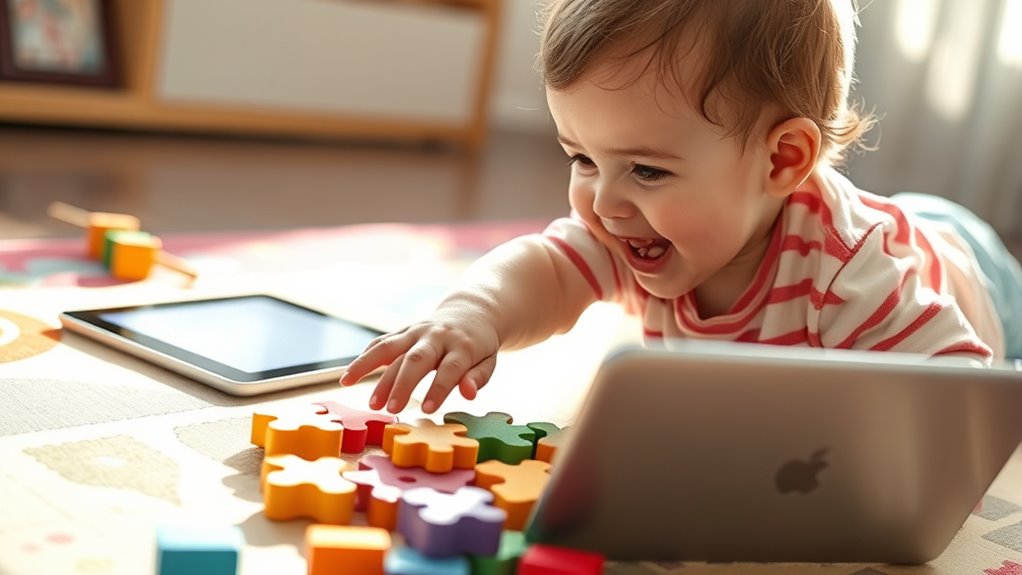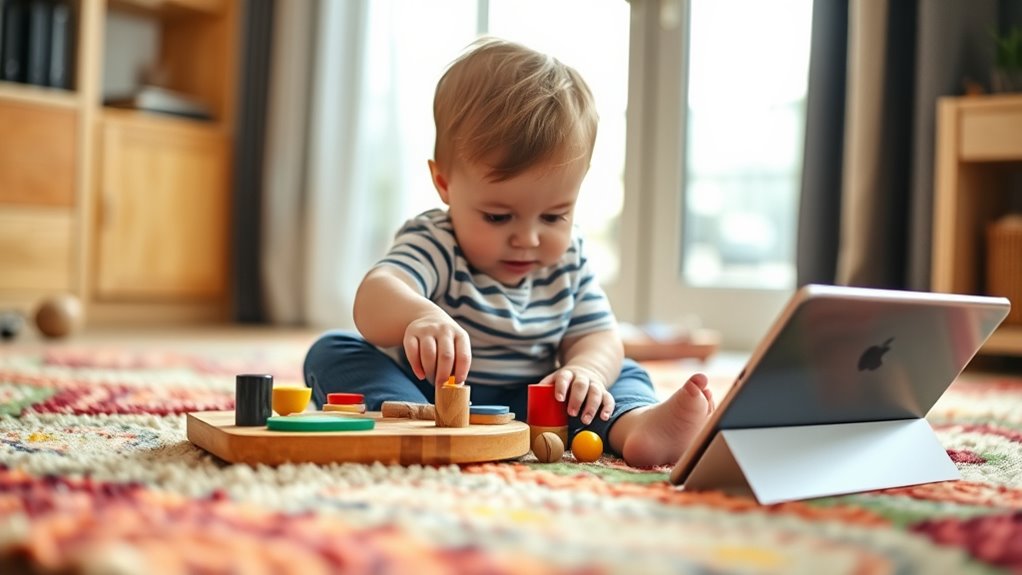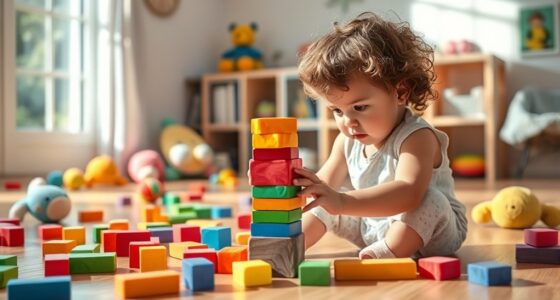You should prioritize real-life experiences for your baby because they support hands-on exploration, social interaction, and sensory learning, which screens can’t provide. Touching objects, engaging with caregivers, and exploring their environment help babies develop vital cognitive and motor skills. Screen time is passive and limited in fostering emotional bonds or physical development. If you want to understand more about why real-world activities are better for your little one, keep exploring the facts.
Key Takeaways
- Real-world interactions stimulate brain development and motor skills more effectively than passive screen time.
- Tactile exploration helps babies understand textures, shapes, and environments better than visual-only screen experiences.
- Face-to-face social interactions teach emotional cues, communication, and empathy essential for healthy development.
- Hands-on activities promote problem-solving, curiosity, and physical coordination beyond what screens can offer.
- Active caregiver involvement during real-life activities fosters stronger bonds and supports holistic growth.

In today’s digital age, screens are everywhere, but when it comes to babies’ development, real-life experiences still outperform digital interactions. As a parent or caregiver, you might wonder if letting your little one watch videos or play with apps can substitute for hands-on experiences. The truth is, nothing replaces the benefits of real-world interactions, especially when it comes to tactile exploration and social interaction. Babies learn best by touching, feeling, and engaging directly with their environment. When they explore objects, they develop their sense of texture, weight, and shape, laying the foundation for cognitive and motor skills. This tactile exploration stimulates the brain and helps them understand the world around them more deeply than passive screen time ever could. Moreover, engaging in sensory play encourages curiosity and supports neural development in ways that screens cannot match.
Real-world experiences foster tactile, social, and cognitive development more effectively than screens for babies.
Social interaction is another critical component of early development that screens can’t truly replace. When you talk, smile, and respond to your baby’s cues, you’re teaching them about communication, empathy, and social norms. These face-to-face interactions build trust and emotional bonds, which are essential for healthy development. Digital screens often lack the nuance of genuine human connection—missing the subtle cues like tone of voice, facial expressions, and body language that help babies learn social cues. By engaging with your baby in real life, you give them opportunities to practice turn-taking, mimicry, and emotional regulation, skills that are crucial for their future relationships.
Furthermore, real-world experiences support physical development in ways screens simply can’t. Crawling, reaching, grasping, and exploring their surroundings help strengthen muscles and coordination. These activities also promote problem-solving and curiosity, as babies learn by manipulating objects and discovering how things work. When you provide a safe environment for tactile exploration, you’re encouraging independence and confidence that digital interactions rarely foster. While screens may offer visual stimulation, they can’t replicate the multisensory input that comes from handling different textures and objects.
Lastly, it’s important to remember that moderation is key. While screens can be educational in some contexts, they should never replace the rich, interactive experiences that come from real-life exploration and social engagement. As a caregiver, your active involvement—encouraging your baby’s tactile exploration, engaging in conversation, and sharing physical activities—creates a foundation for healthy development that screens simply can’t match. Your presence and participation are irreplaceable in guiding your baby through the critical stages of learning and growth.
Frequently Asked Questions
How Early Should Babies Be Introduced to Real-World Experiences?
You should introduce babies to real-world experiences as early as possible, ideally within the first few months. Tactile exploration helps them discover textures and objects, enhancing their senses. Social interaction is vital for emotional development, so engaging with caregivers and others fosters early communication skills. By providing safe, hands-on experiences early on, you support your baby’s natural curiosity and learning, laying a strong foundation for future growth.
Can Screen Time Harm a Baby’s Developing Brain?
Imagine your baby’s brain as a delicate garden needing nurturing, not a storm of screen overload. Excessive screen time can harm their developing brain, risking developmental delay and clouding their natural curiosity. Screens can act like weeds choking their growth, preventing essential sensory experiences. To protect this fragile garden, limit screen exposure and prioritize real-world interactions, ensuring your little one blossoms into a healthy, thriving individual.
What Are Some Effective Real-Life Learning Activities for Infants?
You can help your baby learn effectively through simple activities like sensor play, where they explore different textures, sounds, and tastes, stimulating their senses. Outdoor exploration is also great, allowing your little one to discover nature, experience new sights, and practice movement. These activities encourage curiosity and development more than screen time. By engaging in real-life experiences, you support your baby’s growth and strengthen your connection.
How Can Parents Balance Screen Time and Real-World Interactions?
You can balance screen time and real-world interactions by prioritizing interactive play and sensory exploration. Set limits on screen use, ensuring your baby spends more time engaging with toys, nature, and people. Encourage activities that stimulate their senses and foster curiosity, like exploring textures or listening to different sounds. By actively involving your baby in these experiences, you help develop their skills while reducing reliance on screens.
Are There Any Benefits to Educational Screens for Babies?
Imagine a gentle glow from a screen, offering brief visual stimulation, but beware of digital distraction that pulls your baby’s focus away from the world around them. Educational screens can introduce simple concepts and colorful images that spark curiosity, but they shouldn’t replace hands-on exploration. You can use screens purposefully to complement real-life learning, ensuring your little one benefits from visual engagement without losing the richness of actual experiences.
Conclusion
So, it’s no coincidence that your baby learns best when exploring the world around them. While screens might seem convenient, real-life experiences foster curiosity, development, and genuine connection. The next time you see your little one reaching for a toy or giggling at a face-to-face interaction, remember—those moments are more powerful than any screen. Trust in the magic of real-life learning; it’s what shapes their growth in ways screens simply can’t.









